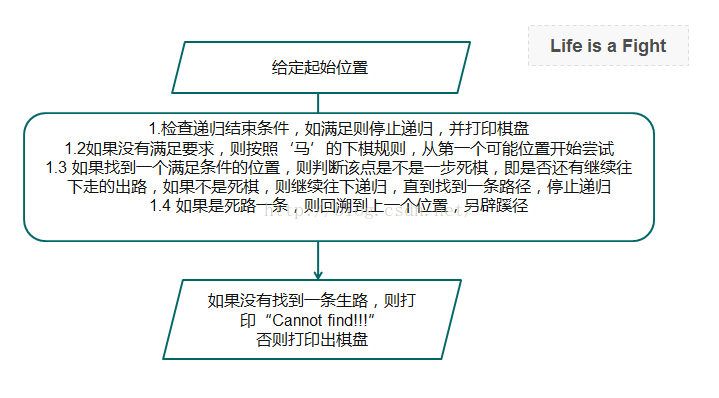C语言-数据结构-骑士周游-马踏棋盘问题-源代码
1. 目标
对于一个指定的起始坐标,按照‘马’的走棋规则,从该坐标开始搜索一条可以覆盖棋盘每个位置的走棋路径。例如下面是从(2,0)坐标开始搜索得到的一个解。
2. 代码结构
3. 源代码
该代码仅仅是寻找到一条生路,即停止。另外对选择的起始点,和寻找下一点的顺序不同(即sposition()中case的顺序不同,对于程序执行的时间影响会很大)。
另外程序中调用了time.h头文件中的clock相关函数,对代码的执行时间进行了统计,具体见代码。
#include
#include
#define title "------------------------------Life is a fight!------------------------------------"
#define X 8 //定义棋盘大小
#define Y 8
int chess[X][Y]= {
{0,0,0,0,0,0,0,0},
{0,0,0,0,0,0,0,0},
{0,0,0,0,0,0,0,0},
{0,0,0,0,0,0,0,0},
{0,0,0,0,0,0,0,0},
{0,0,0,0,0,0,0,0},
{0,0,0,0,0,0,0,0},
{0,0,0,0,0,0,0,0}
};
int sposition(int *x, int *y, int p)
{
switch(p)//特别需要注意每个case 中的顺序,对程序执行的时间有很大影响
{
case 0:
if( *x+2<=X-1 && *y-1>=0 && chess[*x+2][*y-1]==0 )
{
*x = *x + 2;
*y = *y - 1;
return 1;
}
else
return 0;
case 1:
if( *x+2<=X-1 && *y+1<=Y-1 && chess[*x+2][*y+1]==0 )
{
*x = *x + 2;
*y = *y + 1;
return 1;
}
else
return 0;
case 2:
if( *x+1<=X-1 && *y-2>=0 && chess[*x+1][*y-2]==0 )
{
*x = *x + 1;
*y = *y - 2;
return 1;
}
else
return 0;
case 3:
if( *x+1<=X-1 && *y+2<=Y-1 && chess[*x+1][*y+2]==0 )
{
*x = *x + 1;
*y = *y + 2;
return 1;
}
else
return 0;
case 4:
if( *x-2>=0 && *y-1>=0 && chess[*x-2][*y-1]==0 )
{
*x = *x - 2;
*y = *y - 1;
return 1;
}
else
return 0;
case 5:
if( *x-2>=0 && *y+1<=Y-1 && chess[*x-2][*y+1]==0 )
{
*x = *x - 2;
*y = *y + 1;
return 1;
}
else
return 0;
case 6:
if( *x-1>=0 && *y-2>=0 && chess[*x-1][*y-2]==0 )
{
*x = *x - 1;
*y = *y - 2;
return 1;
}
else
return 0;
case 7:
if( *x-1>=0 && *y+2<=Y-1 && chess[*x-1][*y+2]==0 )
{
*x = *x - 1;
*y = *y + 2;
return 1;
}
else
return 0;
default:
return 0;
}
}
void prfChess(int t_chess[][Y])
{
int i, j;
for(i=0;i 
